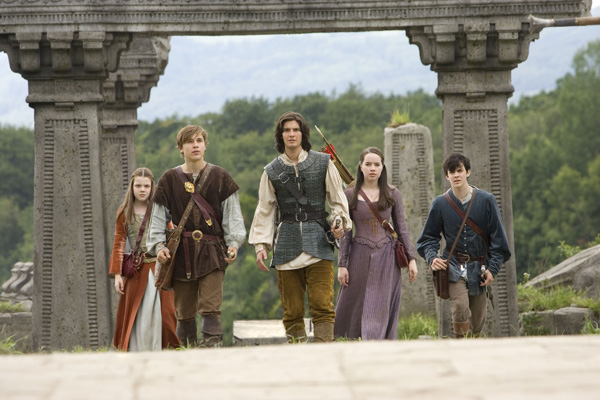Delgo
Posted on December 11, 2008 at 6:00 pm
C| Lowest Recommended Age: | 4th - 6th Grades |
| MPAA Rating: | PG for sequences of fantasy action violence |
| Profanity: | Some insults, some mild crude humor (crotch hit) |
| Alcohol/ Drugs: | None |
| Violence/ Scariness: | A lot of fantasy violence, sad death |
| Diversity Issues: | A theme of the movie |
| Date Released to Theaters: | December 12, 2008 |
The good news is that animation software is so widely available these days that just about anyone can make an animated film. That’s also the bad news. It is now too easy to produce a professional-looking film without the same level of care in story-telling, and that is the problem with the new fantasy film “Delgo.”
It has all-star Hollywood voice talent and some delightfully imaginative visuals, but its professional strengths only sharpen the contrast with the amateurish elements of its script – an over-plotted story and under-written characters.
“Delgo” more closely resembles a 1990’s video game than a feature film. Most of today’s games have stronger plots and the advantage of participant involvement. And today most games have mastered physical properties to provide a believable sense of gravity and motion. In this film, individual characters and creatures are well designed and there is a nice fluidity of movement in close-up. But each moves so independently that we get no sense of how they interact and the characters and objects on screen seem to pass by each other without impact or any relationship to the laws of motion. Even creatures without wings occasionally seem to float and the result is disorienting and distracting.
Delgo (voice of Freddie Prinze, Jr.) is an energetic and sometimes impetuous teenager and a member of the Lockni, a reptilian race that maintains an uneasy truce with the winged Nohrin. When Delgo was a child, Sedessa, the sister of the Nohrin King (Anne Bancroft in her last screen role), attempted a sort of ethnic cleansing to get rid of the Lockni and was banished by her brother. Years later, the two groups still do not trust each other and myths and prejudices have grown as their knowledge of each other has faded.
Kyla (voice of Jennifer Love Hewitt), the curious and independent-minded Nohrin princess, finds Delgo about to fall one day and rescues him. Kyla is kidnapped by Sedessa and Delgo is framed and thrown in jail. He escapes with the help of Bogardus (Val Kilmer), a Nohrin General, who grudgingly begins to join forces with Delgo to rescue the princess, defeat Sedessa, and teach the Nohrin and Lockni how to work together.
The look has an impressive flair and attention to detail. Its biggest weakness is too many characters, too many plot diversions, and too much violence for a very young children. Older kids will find it a weak reprise of better films, with a gravelly-voiced master intoning about using feelings, not thinking, to move the mystical fire-rocks.
The most creative aspect of “Delgo” is the way it was made. For its first feature film, Georgia-based Fathom Studios invited its audience behind the scenes over the past few years, allowing visitors to its website to see internal notes and watch as the visuals of the movie evolved. If they had opened up the screenplay to the same sort of Wiki-esque review process, it might have made the the story on screen as engaging as the story of its development.

 The Pevensie children are back in London and contemporary life seems pale and uninvolving compared to their adventures in the magical land of Narnia. As they wait for the Tube, a wall opens up and just as happened when they went through the wardrobe, they stand before the entryway to Narnia again. This time, they know immediately where they are. What they don’t know is when they are. Everything is different. “I don’t remember any ruins in Narnia,” one says. Lucy (Georgie Henley) confidently approaches a bear, introducing herself as though she was inviting him to tea. But he growls and charges. “I don’t think he could talk at all,” she says with surprise. “If treated like a wild animal long enough, that’s what you become,” explains Trumpkin (Peter Dinklage in heavy gnomish make-up). “You may find Narnia a more savage place than you remember.”
The Pevensie children are back in London and contemporary life seems pale and uninvolving compared to their adventures in the magical land of Narnia. As they wait for the Tube, a wall opens up and just as happened when they went through the wardrobe, they stand before the entryway to Narnia again. This time, they know immediately where they are. What they don’t know is when they are. Everything is different. “I don’t remember any ruins in Narnia,” one says. Lucy (Georgie Henley) confidently approaches a bear, introducing herself as though she was inviting him to tea. But he growls and charges. “I don’t think he could talk at all,” she says with surprise. “If treated like a wild animal long enough, that’s what you become,” explains Trumpkin (Peter Dinklage in heavy gnomish make-up). “You may find Narnia a more savage place than you remember.”